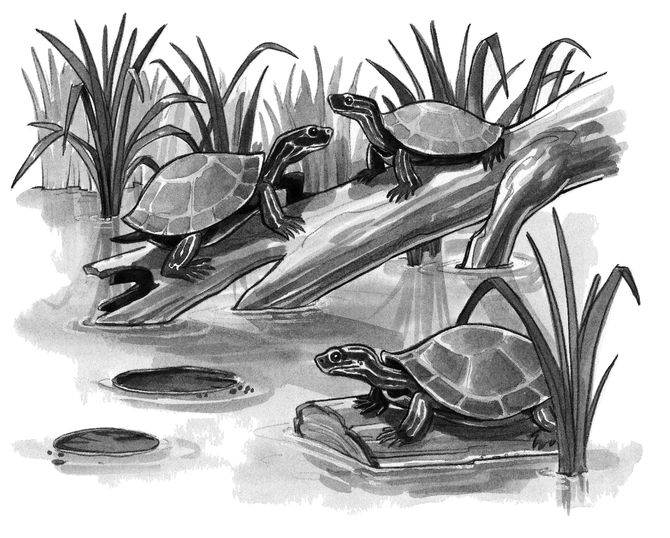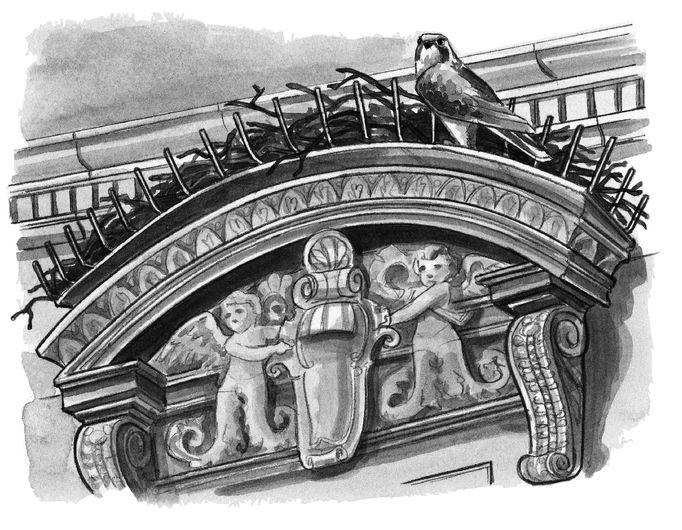Your Backyard Is Wild (6 page)
Read Your Backyard Is Wild Online
Authors: Jeff Corwin

But Benjamin was already having some doubts. The line to get in was long. And it was a beautiful day—the kind of day when his family would usually be outdoors. He didn’t want to be rude, but he just had to ask . . . “Could we go to Central Park instead?” he suggested. “It’s so nice out, and I’d rather see nature alive than nature in a museum!”
His mom winked at him, and he wondered if she’d been thinking the same thing. She added, “I’ve been dying to visit the park since we saw it from the top of the Empire State Building.”
That quickly, it was decided.
The families entered Central Park just as a pair of horses trotted by, pulling an old-fashioned carriage behind them. There were pathways full of runners and bikers. And between them all were patches of grass, some small and some massive, with people reading books or playing ball. It was the busiest park Benjamin had ever seen.
As usual, the kids ran ahead while the parents strolled slowly behind. And soon they were standing in front of the last thing Benjamin ever expected to see in the middle of the city: a lake! People were paddling around on rowboats, taking pictures of the famous buildings that were reflected in the water.
“Oh, we have to rent a boat!” Gabe said. “It’s the only way we’ll be able to see what this lake is really like.” It was as if, after a few days with his cousins, he was starting to think like them.
Each family went rowing in one boat. Across the water, Benjamin could hear his uncle telling Gabe about the history of the park. But Benjamin’s parents, as usual, were focused on the wildlife.
“Benjamin—look,” his mom said. She pointed to a pile of rocks near shore. Benjamin couldn’t see what made them special until they rowed a little closer. That’s when he realized they weren’t rocks at all but a bunch of turtles basking in the sun! “Eastern painted turtles,” his mom said before he had a chance to ask. She knew by the pattern on their shells. “They’re sitting in the sun because they’re cold-blooded and can’t regulate their own body temperature. A good sunbath will keep them warm for a while, though.”

The Baxters rowed up to Gabe’s boat, then pointed their oars so his family could see the turtles. “I just read online that a thirty-pound snapping turtle lives in this lake, too!” Aunt Lily said cheerfully. “He was discovered when some workers had to drain a portion of the lake.”
Benjamin was curious about that one! Snapping turtles were a little more ferocious than other turtles, and thirty pounds was pretty big! He looked for it as he paddled, but there was no sign of it. He did notice a group of mallard ducks and a flock of Canada geese, though. He also saw frogs leaping through in the greenery around the shoreline, though they moved too quickly for him to tell what kind they were. He knew they were frogs, not toads, since they had long legs for hopping and smooth, greenish skin. The skin of toads tended to be browner and drier, and their legs were short and stubby.
When their arms were tired from rowing, the families walked across the park to the East Side and the Central Park Zoo. Benjamin, Lucy, and Gabe spent a long time watching the sea lions at feeding time. They leaped out of the water and snatched fish from their trainers’ hands.
One sea lion even hopped on the rocks and walked on his flippers for the crowd. The trainer smiled proudly at his student, and Benjamin knew how he felt. It was the way he felt, back home, whenever he taught Daisy a new trick.
Later, the cousins sat on a bench outside the zoo, watching the cars and buses drive down Fifth Avenue. Their parents lined up at another street vendor, this time to buy them hot pretzels.
Benjamin caught sight of a woman on the other side of the street walking seven dogs. Were they all hers? he wondered.
“A dog walker,” Gabe told him, following his gaze. “That’s her job. She takes care of the pets while their owners are at work.” Only in New York, thought Benjamin. Daisy would never stand for that!
Then Benjamin watched a bunch of pigeons pecking at the pavement, eating every crumb they could find. Like raccoons, pigeons were perfectly adapted to life in the city, though some people considered them pests.
Just then, Gabe jumped off his bench and pointed into the air. “Pale Male!” he shouted.
Lucy looked to Benjamin for an answer, but he had no idea what Gabe was talking about. He couldn’t even see what Gabe was pointing to.
And then . . . there it was. A magnificent hawk soaring above Fifth Avenue, hovering above the bus fumes and the tour groups until it landed on the roof of a building across the street.
“Was that . . . ?” Lucy asked.
“A red-tailed hawk!” Benjamin cried. He could tell by its broad wingspan and its distinctive red tail feathers.
“What’s he doing here?” Lucy wondered.
“He lives here,” Gabe said.
Both cousins turned to look at him. Gabe wasn’t usually the expert on animals or nature. But this time, he had a lot to tell them.
“Lots of famous people live in the city,” Gabe said. “But Pale Male is one of the most famous animals—so famous that I’ve read about him in school.”
“Well, what’s his story?” Benjamin prompted his cousin.
“Pale Male moved to New York about fifteen years ago,” Gabe said. “Or that’s what the experts think. Bird-watchers saw him building a nest in Central Park, but he didn’t last long there because he was chased away by crows. That’s when he moved across the street! He perched on an apartment building instead of in a tree and built his nest in some fancy stonework above a window.”

“So he still lives there?” Lucy asked.
“Now he does,” replied Gabe. “But not without a fight. The owners of the apartment building tried to make changes to the stonework . . . until people complained. Pale Male and his mate had raised many chicks in that nest, and they’d become part of the neighborhood. Nobody wanted to see them hurt or moved. So now they’re back in their old nest.”
“And that was really him?” Lucy asked, as breathlessly as if she’d seen a movie star.
“I’m not really sure,” Gabe admitted. “But red-tailed hawks are unusual in New York. If it wasn’t him, it definitely could have been another bird in his family.”
“That’s an awesome story,” Benjamin said.
Gabe grinned. “I never paid much attention to it before. You know . . . it’s like the animals in my yard. I never paid attention to them—I hardly knew they were there. You guys have shown me a whole new side of the city. I was supposed to be
your
tour guide! But I’ll never see New York in the same way.”
your
tour guide! But I’ll never see New York in the same way.”
Benjamin thought back to what he’d imagined his trip would be like. He’d thought it would be all about the city’s famous landmarks, but instead it was all about seeing the city’s natural wonders. It wasn’t what he had expected—it was even better. And he would never see New York in the same way again, either!
Before he went to bed that night, Benjamin took out his notebook. Observe and record: it was like his family’s mantra, an easy way to remember how scientists always looked at the world. Benjamin realized he’d done a lot more observing than recording on this trip. He’d been too busy having fun! He didn’t want to forget anything he’d learned, though. And he didn’t want to forget even one detail that he might share with his classmates back home.
He opened the notebook and turned to the pages where he’d done some quick sketches of animals. Now it was time to write about them. To write about all of New York, actually . . . he didn’t know where to begin!
Benjamin chewed his eraser and thought about the most exciting place he’d seen in the city. It wasn’t the subway or the Empire State Building, Brooklyn Heights or even Central Park. It was a place that few tourists would see, but a place that contained some of the city’s greatest surprises.
He turned to a new page and wrote Your the name of it across the top:
Your Backyard
Is Wild
. And then he went to work!
Your Backyard
Is Wild
. And then he went to work!
Other books
Garden of Secrets by Freethy, Barbara
Pure Heat by M. L. Buchman
Dead Radiance by T. G. Ayer
Maldito amor by Marta Rivera De La Cruz
Adam's Bride by Lisa Harris
Best New Zombie Tales Trilogy by James Roy Daley
Dangerous Curves Ahead (Watchers Crew) by Ines Johnson
Blackthorne's Bride by Shana Galen
Vienna by William S. Kirby
